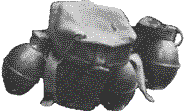After the M-16 rifle, the most common infantry weapon was the
fragmentation grenade. I carried as many as eight: four attached to my ammo pouches,
and four suspended from my shoulder straps. The outside of the grenade was smooth
and about the size of a very large egg. A detonator mechanism sat on top. A
thin metal handle was held in place by a cotter pin with a large metal ring through it.
To use the grenade you placed your finger through the ring and pulled the cotter
pin out. This released the handle, which was flung aside by a concealed spring.
You then disposed of the device as quickly as possible. The timing mechanism
was very reliable. You had five seconds before the grenade exploded. That left
about four seconds to throw it before it removed your hand or head, whichever was closer.
The killing radius was 15 meters, and the injury radius up to 35. You had to
throw it far to keep from sharing the shrapnel with your intended victim.
 Unlike the old World War II pineapple grenade which broke into large fragments,
these had stainless steel wire inside, serrated into thousands of tiny pieces. The
high explosive core pushed the thin shell aside and threw tiny fragments in every
direction. Those fragments were deadly. I never saw one of our grenades fail,
though many enemy grenades were exposed to moisture and didn't work. We were always
grateful Charlie didn't have grenades like ours.
Unlike the old World War II pineapple grenade which broke into large fragments,
these had stainless steel wire inside, serrated into thousands of tiny pieces. The
high explosive core pushed the thin shell aside and threw tiny fragments in every
direction. Those fragments were deadly. I never saw one of our grenades fail,
though many enemy grenades were exposed to moisture and didn't work. We were always
grateful Charlie didn't have grenades like ours.
Of course, sometimes we were our own worst enemies. On night ambush, some GIs
straightened the cotter pins to make them easier to pull, and placed the grenades on the
dike in front of them, ready for use. The pins were thin. After repeated
bending and unbending they broke off. One evening, a month after I had returned from
the field to desk duty in Cu Chi, I drove the battalion officer in charge to the Medevac
hospital to inspect casualties brought in from the field. One man had set his
grenades out as usual, straightening the pins. Unseen in the dark, the broken pin
fell out and the handle ejected. Five seconds later the grenade exploded right in
the faces of the entire squad. Five men were killed, and three seriously wounded.
When we arrived, the five bodies lay beside the helipad, waiting for transportation
to the morgue. Most had no hands, one almost no head. Too late for these men,
a new rule went into effect - no more unbending the pins.

The Fragmentation Grenade: Tales Of A War Far Away
Copyright © 1995 Kirk S. Ramsey
Last modified:
March 02, 1995
